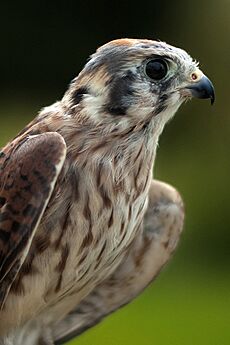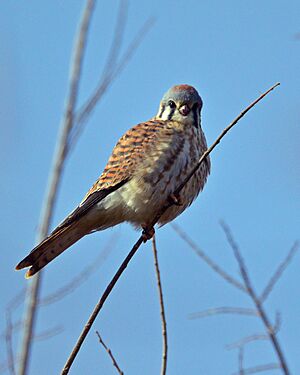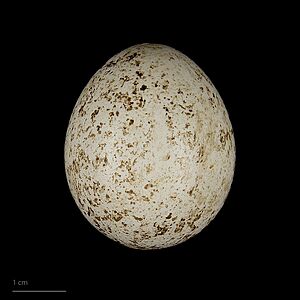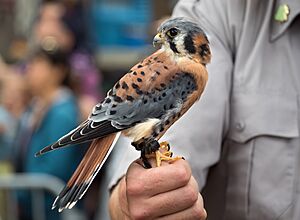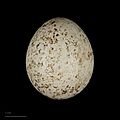American kestrel facts for kids
Quick facts for kids American kestrel |
|
|---|---|
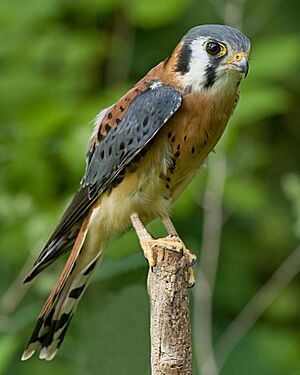 |
|
| Male | |
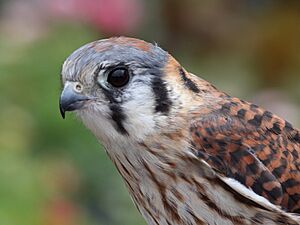 |
|
| Female at the Cincinnati Zoo | |
| Conservation status | |
| Scientific classification | |
| Genus: |
Falco
|
| Species: |
sparverius
|
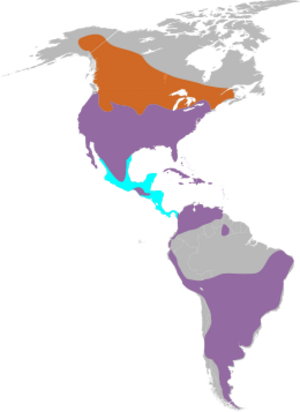 |
|
| American kestrel range
Year round Summer (breeding) Winter (non-breeding) |
|

The American kestrel (Falco sparverius) is the smallest and most common falcon in North America. It is sometimes called the American sparrowhawk. However, this name is a bit misleading. The American kestrel is a true falcon, while the Eurasian sparrowhawk is a different type of bird. Kestrels are found all over North and South America. There are 17 different types, called subspecies, that have adapted to various places.
American kestrels usually hunt by sitting on a perch. They look for prey on the ground and then swoop down. They can also hover in the air, flapping their wings fast, before diving. Their diet includes grasshoppers, other insects, lizards, mice, and small birds. This varied diet helps them thrive. They build nests in holes in trees, cliffs, or buildings. The female lays three to seven eggs. Both parents help to keep the eggs warm.
Many kestrels that breed in Canada and the northern United States fly south for the winter. They can sometimes be seen in Western Europe, but this is rare.
Contents
About the American Kestrel
The American kestrel was once thought to be closely related to European and African kestrels. However, DNA tests show something different. American kestrels are actually more closely related to larger American falcons. These include the peregrine, aplomado, and prairie falcons. Even though their DNA is different, they still look and hunt like other kestrels. This is because they have evolved to fit a similar role in nature.
What's in a Name?
The American kestrel was first officially described in 1758 by Carl Linnaeus. He was a Swedish scientist. For many years, people called it the "sparrow hawk." This was because they thought it was related to the Eurasian sparrowhawk. But in 1983, scientists officially changed its name to "American kestrel." This cleared up the confusion. Some other nicknames for the kestrel are "grasshopper hawk" because of what it eats, and "killy hawk" because of its call.
Kestrel Subspecies Around the Americas
There are 17 different types of American kestrels. Scientists tell them apart by their feathers, size, and calls. These subspecies live in different parts of North and South America. For example, some live in the United States and Canada. Others live in places like Cuba, Jamaica, Venezuela, and Argentina. Each type has adapted to its specific home.
Kestrel Appearance and Sounds
The American kestrel is the smallest bird of prey in America. Males and females look a bit different. Females are usually a little bigger than males. Kestrels are about 22 to 31 centimeters (9 to 12 inches) long. Their wings can spread from 51 to 61 centimeters (20 to 24 inches) wide. Males usually weigh 80 to 143 grams (2.8 to 5 ounces). Females weigh 86 to 165 grams (3 to 5.8 ounces).
Male vs. Female Kestrels
Male kestrels have blue-grey wings with black spots. Their undersides are white with black stripes. Their backs are reddish-brown with stripes on the lower half. The tail is also reddish-brown with a black band near the tip.
Female kestrels have reddish-brown backs and wings with dark brown stripes. Their undersides are creamy with heavy brown streaks. Their tails are reddish-brown with many thin black bars. Young kestrels look similar to the adults.
Both male and female kestrels have white heads with a bluish-grey top. They also have two narrow black stripes on each side of their face. Other falcons usually have only one stripe. Kestrels have two black spots on the back of their neck. These spots might look like "false eyes." This could help protect them from enemies.

Kestrel Calls
American kestrels make three main sounds: the "klee" or "killy," the "whine," and the "chitter."
- The "klee" call sounds like klee, klee, klee, klee. Kestrels use this call when they are upset or excited. Both males and females make this sound.
- The "whine" call is mostly used when they are eating.
- The "chitter" call is used when male and female birds interact. This includes when they are looking for a mate or feeding their babies. Baby kestrels can make adult-like calls when they are about 16 days old.
-
F. s. dominicensis, Jamaica
-
F. s. sparveroides
male red morph, Cuba -
F. s. sparveroides
female white morph, Cuba -
Perched in central Illinois
Kestrel Life and Habits
American kestrels live in many different places. These include grasslands, meadows, deserts, and open areas. They can also live in cities and suburbs. A kestrel needs places to perch, open areas for hunting, and holes for nesting. They can live in very different climates, from the Arctic to the tropics. They are found from northern Canada to the very tip of South America.
Kestrels in Canada and the northern United States usually fly south for the winter. Some go as far as Central America and the Caribbean. Kestrels that live further south usually stay in the same place all year. The females often choose more open areas than males during winter. This might be because the larger females arrive first and claim the best spots.
American kestrels do not live very long in the wild, usually less than 5 years. The oldest wild kestrel found lived for 11 years and 7 months. Kestrels kept by humans can live up to 14–17 years. Humans cause many kestrel deaths, often from cars or direct killing. Larger birds of prey also hunt them.
What Kestrels Eat
American kestrels mostly eat small animals. These include grasshoppers, crickets, butterflies, moths, dragonflies, beetles, lizards, mice, voles, shrews, frogs, and small birds. They have also been known to eat scorpions, snakes, bats, and squirrels. Their wide diet helps them live in many different places.
Kestrels often hunt by sitting on a high spot, like a tree or power line. They wait for prey to come close. They also hunt by hovering in the air, flapping their wings quickly, and looking for prey on the ground. Sometimes, they fly low over fields or chase insects and birds in the air. They usually catch their prey on the ground with their talons. Before they strike, they often bob their head and tail.
During the breeding season, the male kestrel will bring food back to his mate or young. Kestrels are smart hunters. If they are not catching much prey in one area, they will move to a new spot.
How Kestrels Reproduce
American kestrels are ready to have babies by their first spring. In places where they migrate, the males arrive first. Then the female chooses a mate. Kestrel pairs often stay together for life. They usually use the same nesting spots year after year. This helps them know their hunting grounds and avoid predators. Males perform special flying displays to show off their territory and attract a mate. They fly up and dive down, making "klee" calls. The male will also bring food to the female before and after she lays eggs.
Kestrels nest in cavities, which are holes in things. They like natural holes in trees with small entrances. These holes protect their eggs and young. They might also use holes made by large woodpeckers or old nests of other birds. Sometimes, they nest on cliffs, buildings, or even in cactuses. Kestrels also use nesting boxes that people put up for them.
Females lay three to seven eggs, usually four or five. They lay one egg every 24 to 72 hours. The eggs are white or cream-colored with brown or grey spots. The eggs usually hatch after about 30 days. The female does most of the incubating, but the male helps too. The babies hatch over three to four days. They are born helpless and can only sit up after five days. They grow very fast. After 16 to 17 days, they reach adult weight. They are ready to leave the nest when they are 28 to 31 days old.
Young adult kestrels can start breeding when they are one year old. In the wild, they usually live for about three to five years. Older kestrel pairs tend to have more babies than younger ones.
Kestrel Health and Environment
Scientists often study American kestrels to learn about animal health. Kestrels can be affected by their environment. For example, cold and wet weather makes them use more energy to stay warm.
Human activity can also affect kestrels. Nests near busy roads or buildings can stress the birds. This stress can sometimes make it harder for them to have babies.
Kestrels are carnivores, meaning they eat meat. This means that harmful chemicals in their prey can build up in their bodies. For example, some industrial chemicals can weaken their immune system. This makes it harder for them to fight off sickness. These chemicals can also affect their growth and development. Other chemicals can change their feather colors or delay egg laying. This shows how important it is to keep our environment clean for wildlife.
Kestrel Status and Conservation
The American kestrel is probably the most common falcon in North America. However, their numbers have been slowly going down in some areas. For example, in New England and California, their populations are declining faster. There are about 1.2 million pairs in North America. There are also many in Central and South America. In the 1700s and 1800s, their numbers actually grew. This was because forests were cleared for farms, which created good hunting grounds for kestrels.
One type of kestrel in the southeastern U.S. has seen a big drop in numbers. This is because their nesting places, like longleaf pine trees, have been cut down for farms. Despite these declines, the American kestrel is listed as "least concern" by the IUCN Red List. This means they are not currently in danger of disappearing.
Organizations like The Peregrine Fund are working to help kestrels. In 2012, they started the American Kestrel Partnership. This group helps scientists and regular people share information about kestrel nests. They use this information to understand how things like land use, climate, and pollution affect kestrels. They even have a live video feed of a kestrel nest box online!
Kestrels in Falconry
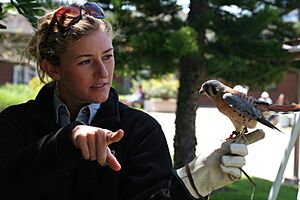
American kestrels are often used in falconry. Falconry is the sport of hunting with trained birds of prey. Kestrels are often suggested for beginners. However, it takes skill to keep a kestrel at the right weight so it wants to hunt. Experienced falconers say kestrels are very good at catching small birds like sparrows and starlings. Some strong kestrels can even catch birds twice their own size, like quail or doves. But for bigger prey, falconers usually prefer larger falcons or hawks.
Kestrels are great for "micro-falconry." This means hunting in smaller areas, like towns or suburbs. They are not as strong or fast as bigger falcons like the merlin. Kestrels are better at ambush hunting and short chases. Falconers often release them from their hand or a car window when they spot prey. This fits the kestrel's natural hunting style.
Falconers must protect their kestrels from other predators. Domestic cats and dogs are a big threat on the ground. The Cooper's hawk is also known to attack kestrels. If a larger hawk attacks, falconers try to scare it away quickly to save their kestrel.
American kestrels are bred in captivity for falconry. They are one of the easier falcons to breed. Wild kestrels are also relatively easy to catch and train. They usually start eating from a falconer's hand the day after being caught. They can be ready to hunt in three to five weeks. A very tame kestrel will let a person pick it up while it eats. This makes it easy to check the bird for injuries or sickness.
It is important to know that owning a wild raptor like an American kestrel requires a special permit in the United States, Canada, and Mexico. This is because they are protected by laws like the Migratory Bird Treaty Act of 1918.
See Also
Images for kids



